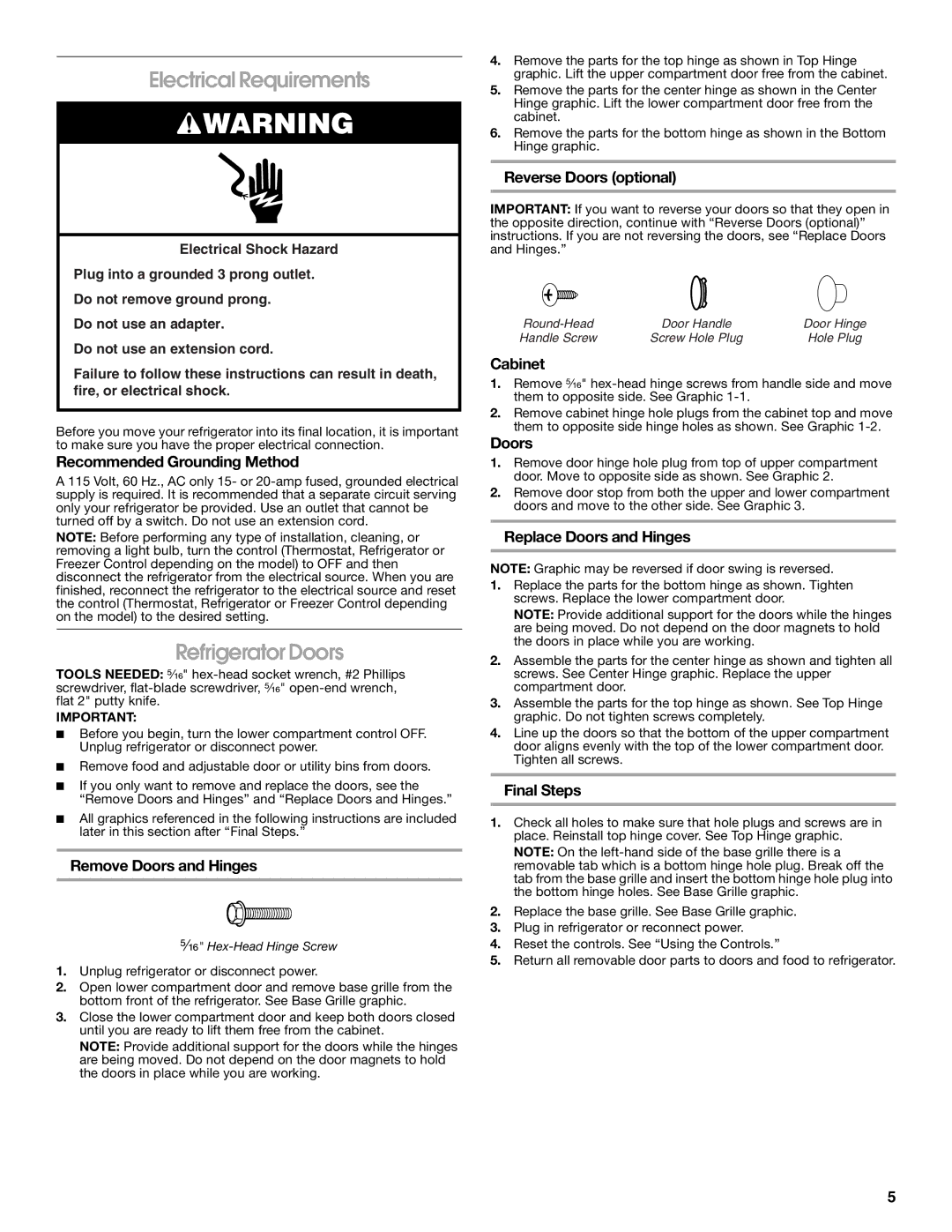
Electrical Requirements
![]() WARNING
WARNING
Electrical Shock Hazard
Plug into a grounded 3 prong outlet.
Do not remove ground prong.
Do not use an adapter.
Do not use an extension cord.
Failure to follow these instructions can result in death, fire, or electrical shock.
Before you move your refrigerator into its final location, it is important to make sure you have the proper electrical connection.
Recommended Grounding Method
A 115 Volt, 60 Hz., AC only 15- or
NOTE: Before performing any type of installation, cleaning, or removing a light bulb, turn the control (Thermostat, Refrigerator or Freezer Control depending on the model) to OFF and then disconnect the refrigerator from the electrical source. When you are finished, reconnect the refrigerator to the electrical source and reset the control (Thermostat, Refrigerator or Freezer Control depending on the model) to the desired setting.
Refrigerator Doors
TOOLS NEEDED: ⁵⁄₁₆"
IMPORTANT:
■Before you begin, turn the lower compartment control OFF. Unplug refrigerator or disconnect power.
■Remove food and adjustable door or utility bins from doors.
■If you only want to remove and replace the doors, see the
“Remove Doors and Hinges” and “Replace Doors and Hinges.”
■All graphics referenced in the following instructions are included later in this section after “Final Steps.”
Remove Doors and Hinges
⁵⁄₁₆" Hex-Head Hinge Screw
1.Unplug refrigerator or disconnect power.
2.Open lower compartment door and remove base grille from the bottom front of the refrigerator. See Base Grille graphic.
3.Close the lower compartment door and keep both doors closed until you are ready to lift them free from the cabinet.
NOTE: Provide additional support for the doors while the hinges are being moved. Do not depend on the door magnets to hold the doors in place while you are working.
4.Remove the parts for the top hinge as shown in Top Hinge graphic. Lift the upper compartment door free from the cabinet.
5.Remove the parts for the center hinge as shown in the Center Hinge graphic. Lift the lower compartment door free from the cabinet.
6.Remove the parts for the bottom hinge as shown in the Bottom Hinge graphic.
Reverse Doors (optional)
IMPORTANT: If you want to reverse your doors so that they open in the opposite direction, continue with “Reverse Doors (optional)” instructions. If you are not reversing the doors, see “Replace Doors and Hinges.”
Door Handle | Door Hinge | |
Handle Screw | Screw Hole Plug | Hole Plug |
Cabinet
1.Remove ⁵⁄₁₆"
2.Remove cabinet hinge hole plugs from the cabinet top and move them to opposite side hinge holes as shown. See Graphic
Doors
1.Remove door hinge hole plug from top of upper compartment door. Move to opposite side as shown. See Graphic 2.
2.Remove door stop from both the upper and lower compartment doors and move to the other side. See Graphic 3.
Replace Doors and Hinges
NOTE: Graphic may be reversed if door swing is reversed.
1.Replace the parts for the bottom hinge as shown. Tighten screws. Replace the lower compartment door.
NOTE: Provide additional support for the doors while the hinges are being moved. Do not depend on the door magnets to hold the doors in place while you are working.
2.Assemble the parts for the center hinge as shown and tighten all screws. See Center Hinge graphic. Replace the upper compartment door.
3.Assemble the parts for the top hinge as shown. See Top Hinge graphic. Do not tighten screws completely.
4.Line up the doors so that the bottom of the upper compartment door aligns evenly with the top of the lower compartment door. Tighten all screws.
Final Steps
1.Check all holes to make sure that hole plugs and screws are in place. Reinstall top hinge cover. See Top Hinge graphic.
NOTE: On the
2.Replace the base grille. See Base Grille graphic.
3.Plug in refrigerator or reconnect power.
4.Reset the controls. See “Using the Controls.”
5.Return all removable door parts to doors and food to refrigerator.
5
